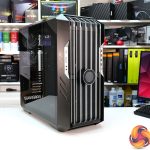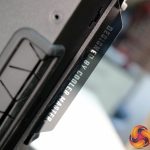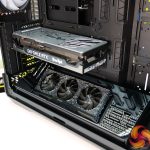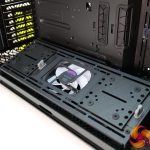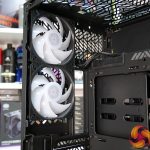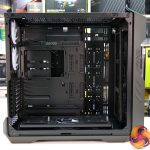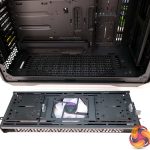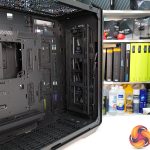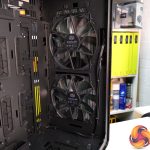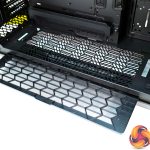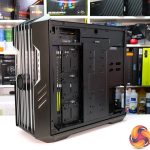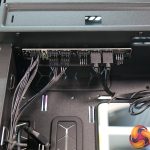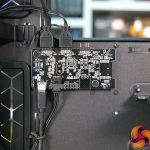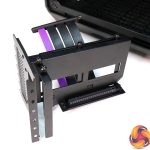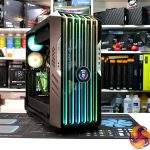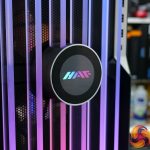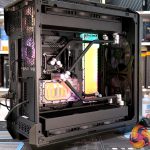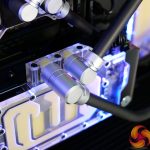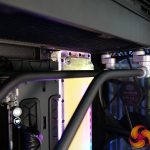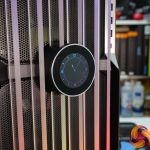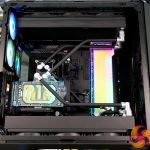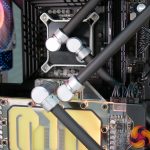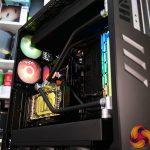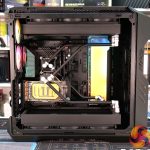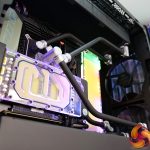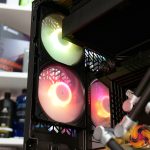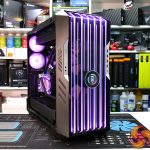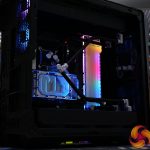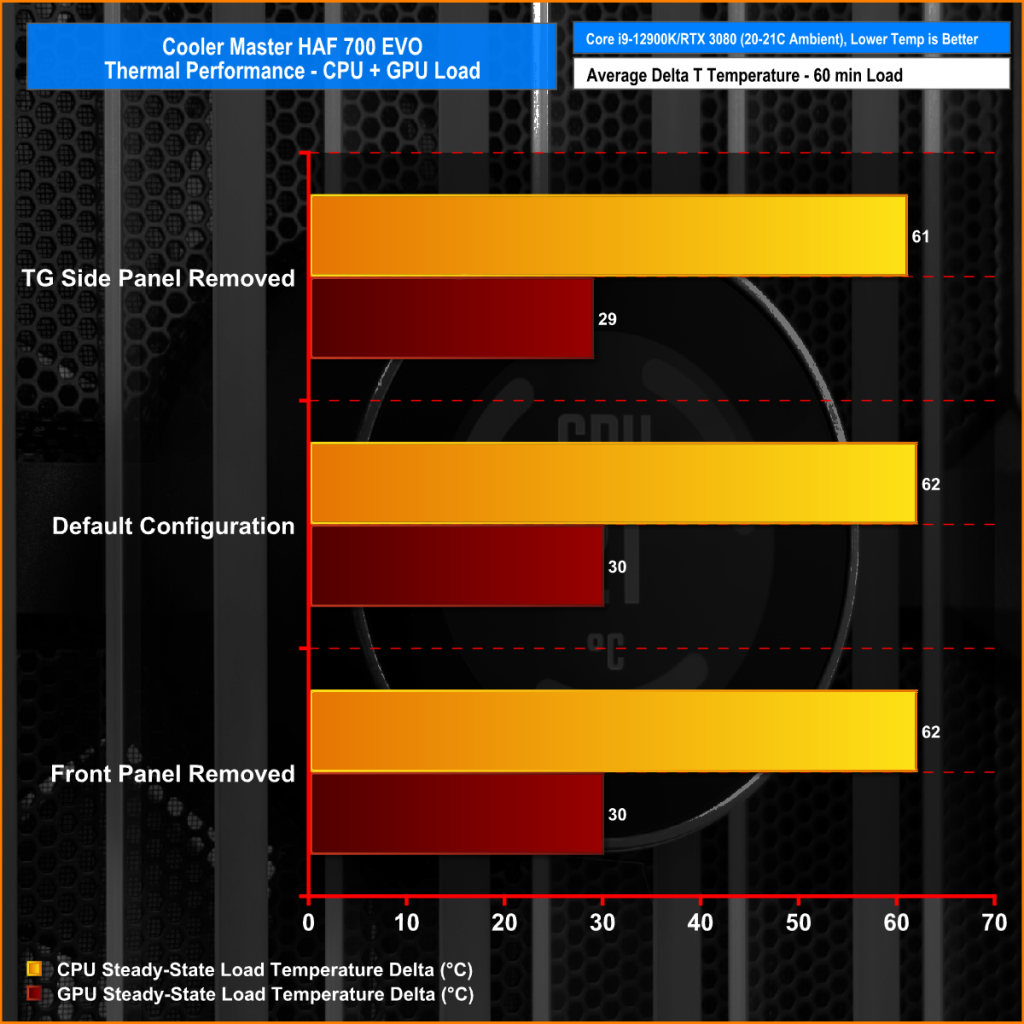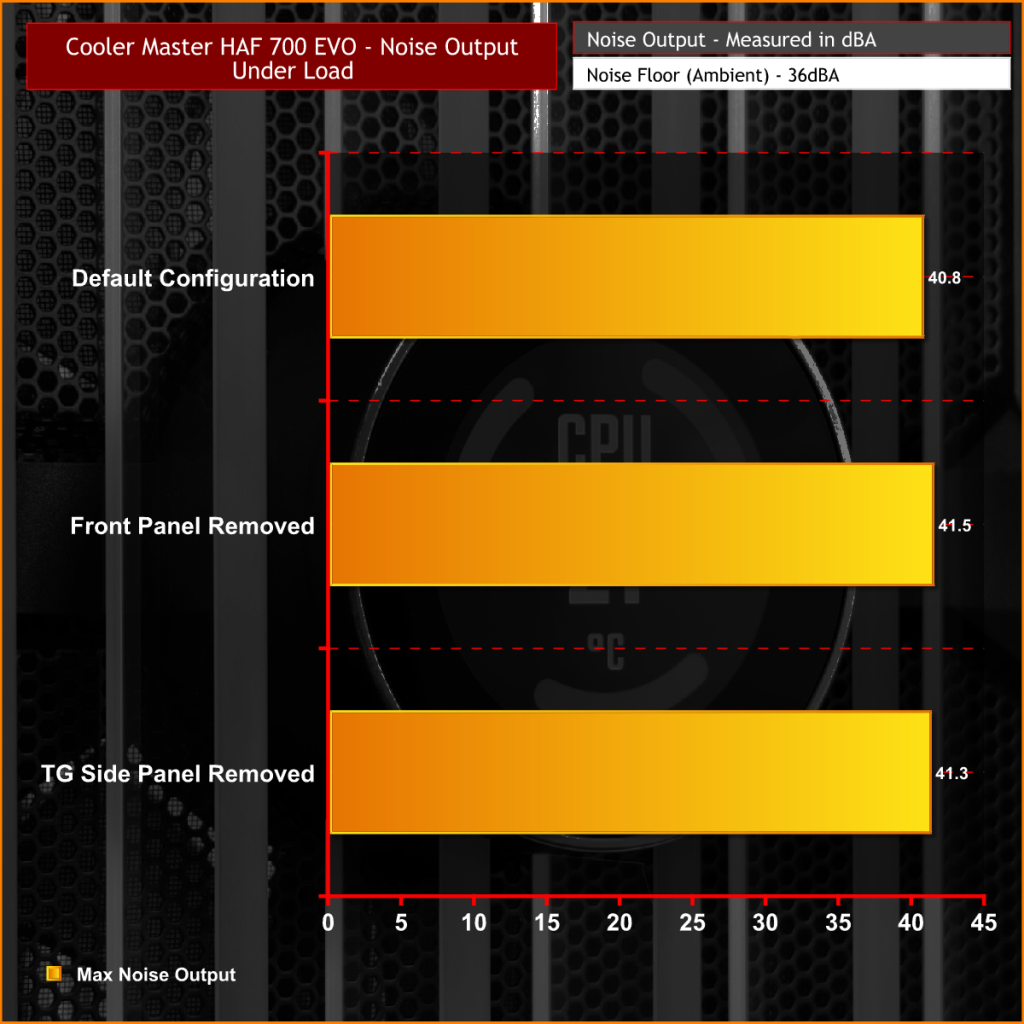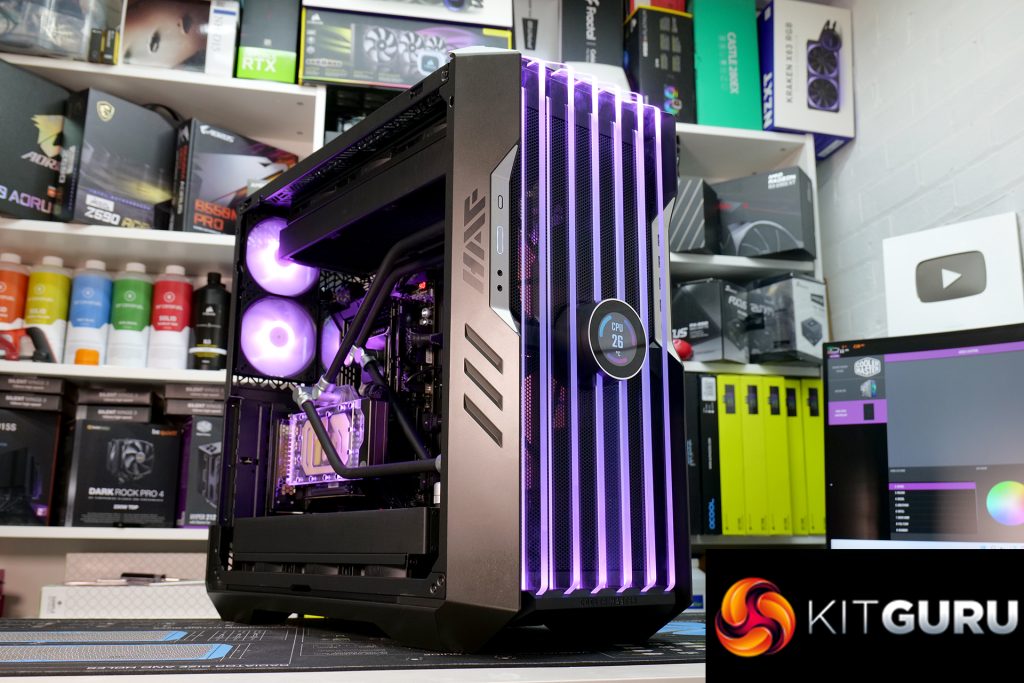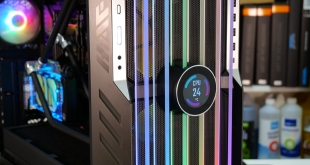
A familiar name from Cooler Master has been resurrected in recent months. The HAF 500 was the first to bring back the company’s high airflow chassis series, but this was a rather tame affair that didn’t inspire Leo with much positivity towards the new line of HAF cases. However, Cooler Master is ready to make its real return to HAF now with the launch of the HAF 700 EVO, a big and bold chassis with some rather interesting features and an eye-watering price tag of £450. But is it any good? Let’s find out.
Not only is the HAF series about high airflow chassis design, but according to Cooler Master it also brings innovative new features that we may see implemented into more or all chassis in the future. So, what’s new in the HAF 700 EVO I hear you say? Well, the engineers have put a big emphasis on tool-free installation which is noticeable as soon as you remove the case panels in preparation to begin your installation.
The top panel sides backwards then lift off to remove, this top panel also locks the side panels in position. Once the top is removed then the left- and right-hand sides pull out and lift away completely tool-free. This tool-free approach extends to the interior of the case with two removable fan/radiator/storage mounting brackets that use a quick-release mechanism allowing the user to completely remove them tool-free.
2.5-inch storage drive installation plates are also attached to the fan mounting brackets via the same quick-release system, more 2.5-inch storage drive plates can also be found with tool-free removal in the right-hand compartment, as well as a four bay 2.5/3.5-inch storage compartment that features tool-free removal of the whole bay plus tool-free installation of 3.5-inch drives on plastic inserts. A total of fifteen 2.5 or 3.5-inch drives can be installed in the chassis at once.
As well as huge storage space, the HAF 700 EVO also has multiple radiator placement options too. The front of the chassis can accept up to a 420mm radiator or three 140mm fans, the same on the chassis floor. In the roof of the case, the user can install either up to two 360mm radiators/six 120mm fans or up to a 420mm radiator/three 140mm fans. There is an additional vertical radiator mount by the side of the motherboard tray which allows for up to a 480mm radiator.
This means that the case should be great for installing a complex custom loop cooling system due to its size and radiator support, we expect to see plenty of exotic builds in the Cooler Master HAF 700 EVO. There has also been a big push on the front panel design with the HAF 700 EVO, tempered glass slats are illuminated by RGB lighting and an LCD Iris display is positioned centrally between the glass which gives the front of the case a very unique look.
Cooler Master HAF 700 EVO Features:
- High airflow front panel design equipped with Cooler Master’s FineMesh V2 mesh, RGB illuminated glass and exclusive Performance Edition SickleFlow 200mm fans designed to maintain great thermal performance.
- A built-in real-time Iris status monitor is positioned in the prime location centrally on the front of the case. Iris is fully customisable via the Cooler Master MasterPlus+ software allowing users to display system info or add their own personal touch.
- Extensive tool-less design minimises the use of screws when assembling the system, saving time for the user. Storage drives, panels, even the GPU and PSU installation are tool-free processes.
- Huge hardware support including motherboards up to E-ATX format with additional cable grommets for oversized motherboards. Up to fifteen 2.5 or 3.5-inch storage drives can be installed at once.
- Extensive cooling support includes radiator locations in the front, floor, top and side with up to 480mm maximum length and a dual-chamber layout to maximise cooling potential.
- Included vertical GPU mounting kit with a PCIe Gen4 riser for complete support of the latest generation graphics cards. The included infinity mirror can also be placed below the graphics card and angled to display the GPU RGB features usually hidden away in horizontal orientation.
- Full integration with Cooler Master MasterPlus+ software allows the user to adjust RGB illumination as well as customise the front-mounted Iris LCD display with system info, a personal logo or other images and animated GIF’s.
System Installation
Due to the size, radiator support and cost of the Cooler Master HAF 700 EVO, we thought it would only be right to install a high-end system with custom cooling to fully test out the limits of the chassis. We are happy to say that the HAF 700 EVO coped with everything very well. Installing two large radiators wasn’t a problem, two 420mm EK Coolstream CE (45mm thick) radiators could easily be installed in the floor and roof of the case together.
This also allowed for an EK Quantum Kinetic FLT 360 flat reservoir to be installed in the side rad mount having to worry about interference with the radiators. Alternatively, there would be enough space for two dual-pump/res combos for dual loop configurations or a side-mounted rad for a total of three radiators in the loop.
So space isn’t an issue in the HAF 700 EVO and to be honest the whole build went very smoothly. The tool-less features all worked well however, there was some interference with our 140mm fans when three were installed in the removable brackets together. A rivet head gets in the way a little which means you must force the fan bracket lid closed which marks up the fan housing.
Another minor issue was with the GPU vertical mounting, the initial installation of the vertical mount is great, as it fits in the case tool-less. But once the graphics card is installed, the mount sags under the weight of the GPU. This can be remedied by bending the vertical mount upwards a little which isn’t ideal in a case that costs £450, I expected the vertical mount to be stronger.
The build turned out well in the end though. If anything, we could have thrown more hardware into the case and it would have still not looked too overcrowded. Cable management was a breeze with the large cable channel and integrated cable clips, there was no need to be super neat with the cables as the storage drive panel covers all the cables anyway.
System Specification:
- Case – Cooler Master HAF 700 EVO
- CPU – Intel Core i9-12900K
- Motherboard – Asus ROG Z690 Maximus Hero
- Memory – 32GB (16GB x2) Kingston Fury Beast DDR5 5200MHz
- Graphics Card – Palit RTX 3080 Gaming Pro
- 1st M.2 SSD Drive – 1TB PNY XLR8 Gaming CS3040 PCIe Gen4 NVME M.2 SSD
- Power Supply – Seasonic Prime TX850 80+ Titanium Certified
- Case Fans – Stock 20mm + 120mm Cooler Master SickleFlow
- Operating System – Windows 11
Custom Liquid Cooling Components:
- CPU Water Block – EK-Quantum Magnitude – 115x Nickel/Acetal
- GPU Water Block – EK-Quantum Vector RE RTX 3080/3090 D-RGB – Nickel + Plexi
- Pump / Res Combo – EK-Quantum Kinetic FLT 360 DDC PWM D-RGB – Plexi
- Radiators – 2 x EK-CoolStream CE 420 (Triple)
- Fittings – EK-Quantum Torque HDC 14 – Satin Titanium
- Tubing – Corsair Hydro X Series XT Hardline 14mm Tubing — Satin Black
Thermal/Noise Performance Testing
To simulate thermal demand we run the Cinebench R23 multi-thread benchmark and 3DMark Time Spy Extreme stress test simultaneously in a loop for 60 minutes to fully load the system. This should give the CPU and GPU enough time to reach constant steady-state temperature. With this data, we can compare how the system handles the thermal demand and measure peak noise levels.
Thermal performance is measured with the case in various configurations, such as the default, with the tempered glass left-hand side panel removed and with the front panel removed to see how these configurations affect the CPU and GPU temperature. During testing, only stock case fans are used unless otherwise specified. All water pumps are set to maximum RPM and fans are set to a fixed RPM by the Motherboard software/BIOS.
All temperature measurements are presented as Deltas – meaning the ambient temperature has been deducted from the CPU temperature giving us a Delta. Data shown in the charts represent the average component temperature over the length of the test as measured by HWiNFO and then calculated to get the average. Ambient temperature during thermal tests is between 20-21⁰C.
Noise levels are measured by placing a noise meter 300mm from the front of the chassis while the stress test is running and the peak noise level during the test is recorded. The noise floor (ambient noise level) in the room is 36dBA.
Thermal Performance Overview
With dual 420mm radiators in a custom loop, thermal performance was always going to be good. But as you can see removing panels didn't have much, if any effect on the CPU or GPU temperature under load which shows that the HAF 700 EVO has good airflow and is able to keep a high-end system cool.
Noise Levels Under Load
During the thermal tests, radiator fans were fixed to 850RPM and the front 200mm intake fans were fixed at 500RPM which meant that noise levels were on the low side. Removing panels only slightly increased noise levels but the system noise was still not distracting at all.
Closing Thoughts
There’s no doubt that the Cooler Master HAF 700 EVO is a brilliant case for installing a high-end system with an elaborate custom loop cooling setup. The available space combined with the option for installing multiple big radiators should appeal to water cooing enthusiasts looking to build a dual-loop or two or three radiator cooling system, while still being able to fit in multiple 2.5-inch or 3.5-inch storage drives.
The engineers at Cooler Master that designed the HAF 700 EVO put a big emphasis on making the installation of typical parts such as the PSU, GPU and storage drives as quick and simple as possible with the tool-less brackets and screw-free processes. All these features work as intended, for sure they speed up the installation process and most of the brackets/fittings feel pretty sturdy and well built.
There are the odd exceptions to the rule though, such as the vertical GPU mount which produces noticeable sag once the graphics card is installed. This can be rectified by manually bending the bracket upwards, but as we mentioned earlier this seems a little disappointing from a case that costs £450. We expected only the highest build quality in such an expensive chassis.
Installing three 140mm fans inside the removable fan brackets can pose a problem too, this may depend on the shape of the fan frames but the EK-Vardar fans we used in the build with very square frames caught on the rivet head in the bracket, which made it very awkward to close the bracket lid and caused a little damage to the fan frame, but nothing major. Cooler Master could fix this by fitting the rivet from the other side so the rivet head was flush on the inside.
Overall though, it was a very pleasing experience installing a custom loop system inside this case. Our two 45mm-thick 420mm radiators were accommodated easily, along with the EK-Quantum Kinetic FLT 360 flat reservoir. The finished product looked great too, the EKWB RGB lighting could be easily hooked up to the chassis’ RGB controller and with minor tweaking in the Cooler Master MasterPlus+ software, the RGB synchronised perfectly.
Another nice touch with the HAF 700 EVO is the front panel. If you are an RGB enthusiast then you will like the look of the HAF 700 from the front. The combination of RGB illuminated glass and the LCD Iris display looks the business. The LCD display can also be easily configured and customised using the MasterPlus+ software. Having the display on the front of the case makes it easy for the user to keep an eye on system info or add personalisation.
We like the Cooler Master HAF 700 EVO, it's certainly different when compared to other cases on the market. It sits in a similar sector as big cases like the Corsair Obsidian 1000D but in terms of looks and ease of installation, the HAF 700 is better in almost every department, the only area that the 1000D wins is with its dual system support.
The only stumbling block is the price. At £450 it's at the very top end of the scale for a case. It's not like the HAF 700 EVO is made from exotic materials, just the usual mix of steel, plastic and tempered glass. The features such as the tool-less installation, support for multiple large rads and extensive storage options as well as included accessories like the vertical GPU mount, PCIe Gen4 Riser and the mirror are all great but do they make the case worth £450? That is something you will have to decide for yourself.
The Cooler Master HAF 700 EVO will be available to purchase for £449.99.
Discuss on our Facebook page HERE.
Pros:
- Abundant space for custom liquid cooling.
- Unique front panel design with RGB illuminated glass.
- The front LCD display is great for checking system info.
- Tool-free removal of panels and parts.
Cons:
- Difficult to install three 140mm fans in the mounting brackets.
- GPU vertical mount is quite flimsy.
- Expensive.
KitGuru says: The Cooler Master HAF 700 EVO certainly looks the bee's knees and if you are willing to splash out £450 on a case, you will find that it is a great chassis to build a system with. But after spending time using the case we still can't decide whether it's worth the money. Let us know what you guys think of it.
 KitGuru KitGuru.net – Tech News | Hardware News | Hardware Reviews | IOS | Mobile | Gaming | Graphics Cards
KitGuru KitGuru.net – Tech News | Hardware News | Hardware Reviews | IOS | Mobile | Gaming | Graphics Cards


